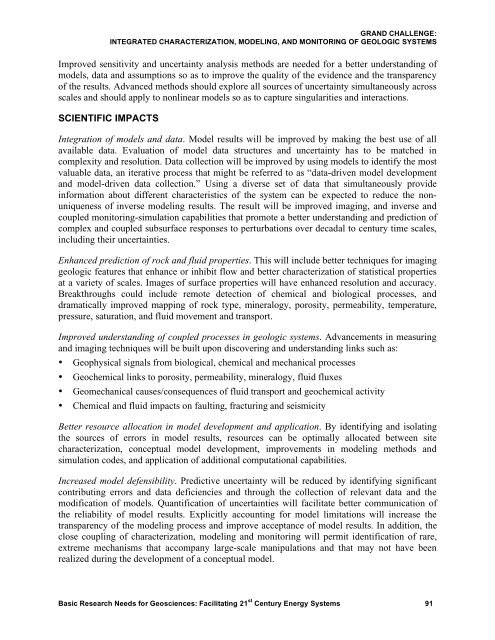Basic Research Needs for Geosciences - Energetics Meetings and ...
Basic Research Needs for Geosciences - Energetics Meetings and ...
Basic Research Needs for Geosciences - Energetics Meetings and ...
- No tags were found...
You also want an ePaper? Increase the reach of your titles
YUMPU automatically turns print PDFs into web optimized ePapers that Google loves.
GRAND CHALLENGE:INTEGRATED CHARACTERIZATION, MODELING, AND MONITORING OF GEOLOGIC SYSTEMSImproved sensitivity <strong>and</strong> uncertainty analysis methods are needed <strong>for</strong> a better underst<strong>and</strong>ing ofmodels, data <strong>and</strong> assumptions so as to improve the quality of the evidence <strong>and</strong> the transparencyof the results. Advanced methods should explore all sources of uncertainty simultaneously acrossscales <strong>and</strong> should apply to nonlinear models so as to capture singularities <strong>and</strong> interactions.SCIENTIFIC IMPACTSIntegration of models <strong>and</strong> data. Model results will be improved by making the best use of allavailable data. Evaluation of model data structures <strong>and</strong> uncertainty has to be matched incomplexity <strong>and</strong> resolution. Data collection will be improved by using models to identify the mostvaluable data, an iterative process that might be referred to as “data-driven model development<strong>and</strong> model-driven data collection.” Using a diverse set of data that simultaneously providein<strong>for</strong>mation about different characteristics of the system can be expected to reduce the nonuniquenessof inverse modeling results. The result will be improved imaging, <strong>and</strong> inverse <strong>and</strong>coupled monitoring-simulation capabilities that promote a better underst<strong>and</strong>ing <strong>and</strong> prediction ofcomplex <strong>and</strong> coupled subsurface responses to perturbations over decadal to century time scales,including their uncertainties.Enhanced prediction of rock <strong>and</strong> fluid properties. This will include better techniques <strong>for</strong> imaginggeologic features that enhance or inhibit flow <strong>and</strong> better characterization of statistical propertiesat a variety of scales. Images of surface properties will have enhanced resolution <strong>and</strong> accuracy.Breakthroughs could include remote detection of chemical <strong>and</strong> biological processes, <strong>and</strong>dramatically improved mapping of rock type, mineralogy, porosity, permeability, temperature,pressure, saturation, <strong>and</strong> fluid movement <strong>and</strong> transport.Improved underst<strong>and</strong>ing of coupled processes in geologic systems. Advancements in measuring<strong>and</strong> imaging techniques will be built upon discovering <strong>and</strong> underst<strong>and</strong>ing links such as:• Geophysical signals from biological, chemical <strong>and</strong> mechanical processes• Geochemical links to porosity, permeability, mineralogy, fluid fluxes• Geomechanical causes/consequences of fluid transport <strong>and</strong> geochemical activity• Chemical <strong>and</strong> fluid impacts on faulting, fracturing <strong>and</strong> seismicityBetter resource allocation in model development <strong>and</strong> application. By identifying <strong>and</strong> isolatingthe sources of errors in model results, resources can be optimally allocated between sitecharacterization, conceptual model development, improvements in modeling methods <strong>and</strong>simulation codes, <strong>and</strong> application of additional computational capabilities.Increased model defensibility. Predictive uncertainty will be reduced by identifying significantcontributing errors <strong>and</strong> data deficiencies <strong>and</strong> through the collection of relevant data <strong>and</strong> themodification of models. Quantification of uncertainties will facilitate better communication ofthe reliability of model results. Explicitly accounting <strong>for</strong> model limitations will increase thetransparency of the modeling process <strong>and</strong> improve acceptance of model results. In addition, theclose coupling of characterization, modeling <strong>and</strong> monitoring will permit identification of rare,extreme mechanisms that accompany large-scale manipulations <strong>and</strong> that may not have beenrealized during the development of a conceptual model.<strong>Basic</strong> <strong>Research</strong> <strong>Needs</strong> <strong>for</strong> <strong>Geosciences</strong>: Facilitating 21 st Century Energy Systems 91
















